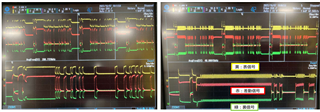There are two devices being used in the same application.
Device "A" : SN65LBC176
Device "B" : SN65LBC176A
It seems there are quite a few little differences between these two parts; timings and ESD protection being two of them.
There has been some oscillations/ringing observed with Device "A" only.
Below waveforms (YELLOW = Pin#6 (A) // GREEN = Pin#7 (B)) are the differential outputs.
Left-Image is a "good example" with no ringing; and Right-image is a "bad example" with ringing (2nd image has trouble with B output))
Is there any idea what could be causing this behavior?
i.e. I know slow inputs on D(pin#4) could cause unstable behavior; does this seem possible given the waveforms?
If so, are there different input transition Tr/Tf requirements for the two devices (max/min)?
https://e2e.ti.com/support/logic-group/logic/f/logic-forum/737694/faq-how-does-a-slow-or-floating-input-affect-a-cmos-device



